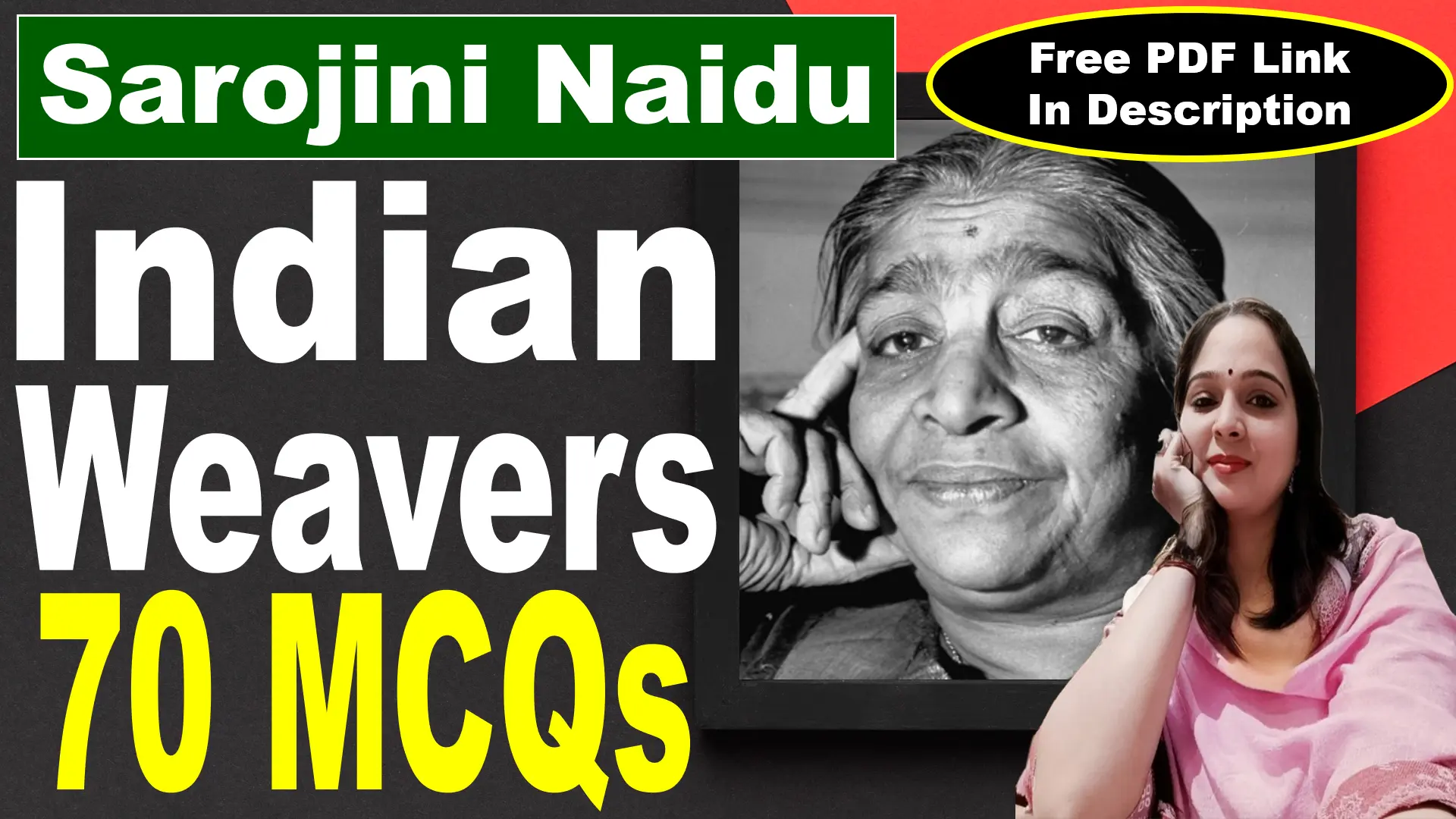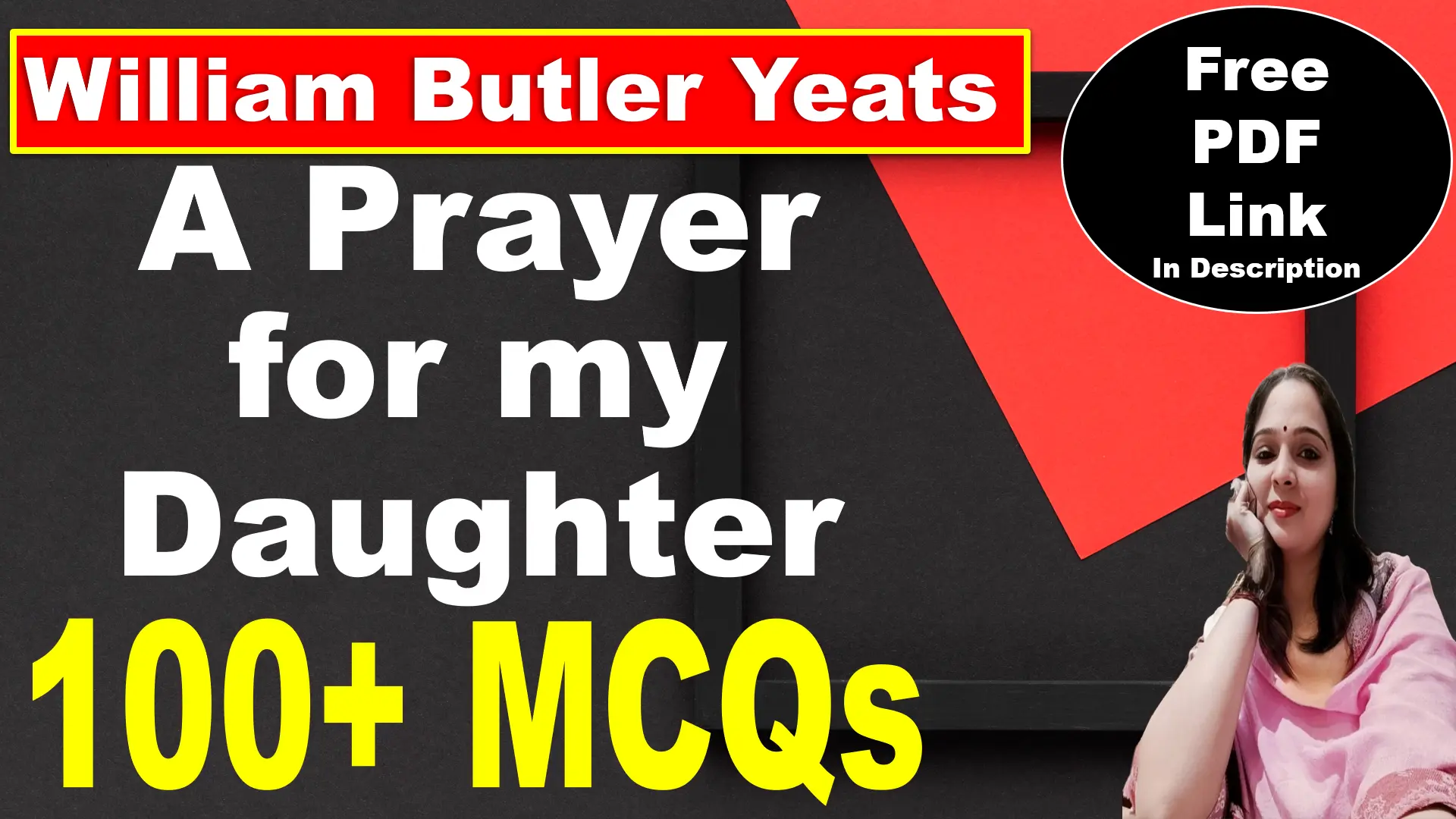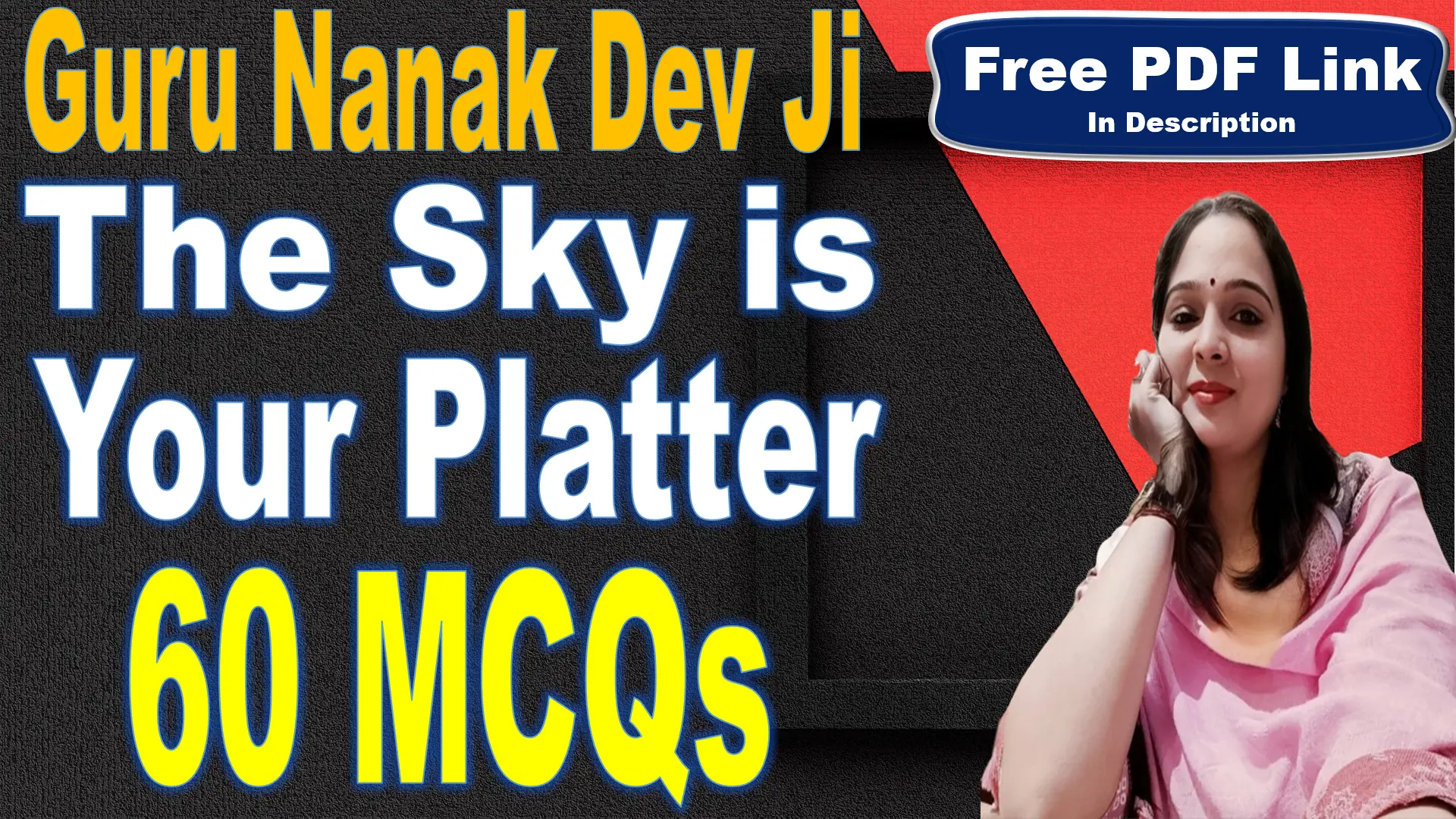
101. Which poet’s collection Only the Soul Knows How to Sing reflects feminist themes?
a) Sarojini Naidu
b) Meena Alexander
c) Kamala Das
d) Eunice de Souza
Answer: c) Kamala Das
Explanation: Only the Soul Knows How to Sing is a poetry collection by Kamala Das, an Indian poet renowned for her bold and confessional style. The work reflects feminist themes through its exploration of female desire, identity, and resistance against patriarchal norms, hallmarks of Das’s writing.
102. Which novel by Anita Desai explores the life of a Urdu poet?
a) Clear Light of Day
b) In Custody
c) The Village by the Sea
d) Fasting, Feasting
Answer: b) In Custody
Explanation: In Custody by Anita Desai follows Deven, a Hindi lecturer, who becomes involved with Nur, an aging Urdu poet, exploring the decline of Urdu literature in post-Partition India. Desai’s nuanced prose captures cultural loss and personal disillusionment. Clear Light of Day focuses on family ties in Delhi, The Village by the Sea on rural resilience, and Fasting, Feasting on gender and cultural contrasts. Only In Custody centers on an Urdu poet’s life, making b) the right choice for its poignant literary focus.
103. Who wrote The Sialkot Saga, a historical thriller spanning centuries?
a) Shashi Tharoor
b) Ashwin Sanghi
c) Amish Tripathi
d) Vikram Chandra
Answer: b) Ashwin Sanghi
Explanation: The Sialkot Saga by Ashwin Sanghi is a historical thriller that spans from ancient India to the modern era, intertwining two parallel narratives involving business, politics, and ancient secrets. Sanghi is known for blending history with suspense, as seen in works like The Rozabal Line.
104. Which novel by Ruskin Bond tells the story of a young girl during the 1857 uprising?
a) The Blue Umbrella
b) Delhi Is Not Far
c) A Flight of Pigeons
d) The Room on the Roof
Answer: c) A Flight of Pigeons
Explanation: A Flight of Pigeons by Ruskin Bond is a novella set during the 1857 Indian uprising, narrating the story of Ruth Labadoor, a young British girl, and her family caught in the conflict, based on historical accounts. Bond adapts this tale with his characteristic simplicity. The Room on the Roof is about adolescent rebellion, The Blue Umbrella a Himalayan village story, and Delhi Is Not Far a small-town narrative. Only A Flight of Pigeons ties to the 1857 uprising.
105. Who is the author of River of Smoke, the second book in the Ibis Trilogy?
a) Amitav Ghosh
b) Vikram Seth
c) Salman Rushdie
d) Rohinton Mistry
Answer: a) Amitav Ghosh
Explanation: River of Smoke is the second book in Amitav Ghosh’s Ibis Trilogy, following Sea of Poppies. It explores the opium trade in the 19th century, focusing on characters in Canton and Mauritius, with Ghosh’s rich historical detail.
106. Which novel by Chetan Bhagat explores cricket and small-town dreams?
a) Half Girlfriend
b) The 3 Mistakes of My Life
c) One Indian Girl
d) Revolution 2020
Answer: b) The 3 Mistakes of My Life
Explanation: The 3 Mistakes of My Life by Chetan Bhagat is set in Ahmedabad, where three friends chase dreams tied to cricket, business, and love, reflecting small-town aspirations. Cricket drives the plot as one character mentors a young player. Half Girlfriend explores a rural-urban romance, One Indian Girl gender dynamics, and Revolution 2020 corruption and ambition. Only b) combines cricket with small-town dreams, making it the right answer in Bhagat’s relatable style.
107. Who wrote Two Leaves and a Bud, a novel about tea plantation workers?
a) Raja Rao
b) Bhabani Bhattacharya
c) Mulk Raj Anand
d) R.K. Narayan
Answer: c) Mulk Raj Anand
Explanation: Two Leaves and a Bud by Mulk Raj Anand is a socially conscious novel exposing the exploitation of tea plantation workers in Assam under British colonial rule. Anand’s focus on the marginalized aligns with his works like Coolie.
108. What social practice does “The Fakeer of Jungheera” critique?
a) Child marriage
b) Sati (widow immolation)
c) Caste system
d) British taxation
Answer: b) Sati (widow immolation)
Explanation: In “The Fakeer of Jungheera,” Henry Louis Vivian Derozio critiques the social practice of sati, the traditional Hindu custom where a widow would immolate herself on her husband’s funeral pyre. The poem, published posthumously in 1832, tells the story of a young widow, Nuleeni, who is rescued from this fate by a bandit-turned-fakeer, only to face tragic consequences. Derozio uses this narrative to challenge the brutality and injustice of sati, reflecting his reformist zeal and his opposition to oppressive customs prevalent in 19th-century India.
109. Which novel by Shashi Tharoor is a fictional retelling of communal riots?
a) Show Business
b) Riot
c) Why I Am a Hindu
d) The Great Indian Novel
Answer: b) Riot
Explanation: Riot by Shashi Tharoor is a novel that fictionalizes the complexities of communal riots in India, using multiple perspectives to explore love, religion, and violence, inspired by real events. The Great Indian Novel reimagines the Mahabharata, Show Business satirizes Bollywood, and Why I Am a Hindu is non-fiction. Only Riot directly addresses communal tensions in a fictional narrative, making it the right choice.
110. Who wrote The Dark Room, a novel about a woman’s domestic struggles?
a) Kamala Markandaya
b) R.K. Narayan
c) Anita Desai
d) Shashi Deshpande
Answer: b) R.K. Narayan
Explanation: The Dark Room by R.K. Narayan, set in Malgudi, portrays Savitri, a woman grappling with her husband’s infidelity and her stifling domestic life, highlighting gender roles and resilience. Narayan’s subtle humor and insight shine through.
111. Which novel by Vikram Seth is a tale of love and music set in Europe?
a) Two Lives
b) The Golden Gate
c) An Equal Music
d) A Suitable Boy
Answer: c) An Equal Music
Explanation: An Equal Music by Vikram Seth is a poignant novel set in Europe, primarily London and Vienna, focusing on Michael, a violinist, and his rekindled love with Julia, a pianist, against the backdrop of classical music. The story delves into passion, loss, and the power of music. A Suitable Boy is set in India, The Golden Gate is a verse novel in San Francisco, and Two Lives is a biographical narrative. Only An Equal Music combines love and music in a European setting.
112. Who is the author of Before We Visit the Goddess, a multi-generational family saga?
a) Chitra Banerjee Divakaruni
b) Jhumpa Lahiri
c) Anita Desai
d) Arundhati Roy
Answer: a) Chitra Banerjee Divakaruni
Explanation: Before We Visit the Goddess by Chitra Banerjee Divakaruni is a multi-generational tale spanning India and the U.S., following three women—Sabitri, Bela, and Tara—across decades, exploring family ties and personal struggles. Divakaruni’s lyrical storytelling shines here.
113. Which poet wrote Crossing of Rivers, reflecting on urban and natural landscapes?
a) Nissim Ezekiel
b) Arun Kolatkar
c) Keki N. Daruwalla
d) Jayanta Mahapatra
Answer: c) Keki N. Daruwalla
Explanation: Crossing of Rivers is a poetry collection by Keki N. Daruwalla, known for his vivid imagery and reflections on both urban decay and natural beauty, often with a rugged, introspective tone. His work contrasts cityscapes with rivers and wilderness.
114. What was a significant influence on Derozio’s poetic style?
a) Sanskrit literature
b) British Romanticism
c) Persian poetry
d) Bengali folk tales
Answer: b) British Romanticism
Explanation: Henry Louis Vivian Derozio’s poetic style was significantly influenced by British Romanticism, a literary movement prominent in the late 18th and early 19th centuries. Born in 1809 in Calcutta to an Anglo-Indian family, Derozio was educated in English and exposed to the works of Romantic poets like Lord Byron, Percy Bysshe Shelley, and John Keats. This influence is evident in his use of lyrical language, emotional intensity, and themes of individualism, nature, and social reform. Poems like “The Harp of India” and “To India, My Native Land” showcase his Romantic sensibilities—combining a reverence for India’s past with a passionate call for its awakening, akin to the Romantic ideal of celebrating the sublime and challenging societal norms.
115. Who wrote The Financial Expert, a novel about a moneylender in Malgudi?
a) R.K. Narayan
b) Raja Rao
c) Mulk Raj Anand
d) Ruskin Bond
Answer: a) R.K. Narayan
Explanation: The Financial Expert by R.K. Narayan is set in the fictional town of Malgudi and follows Margayya, a moneylender whose ambitions lead to both success and downfall, told with Narayan’s trademark humor and insight.
116. What is a central theme in Derozio’s “The Fakeer of Jungheera”?
a) Colonial oppression
b) Romantic love and social critique
c) Nature’s beauty
d) Religious devotion
Answer: b) Romantic love and social critique
Explanation: A central theme in Henry Louis Vivian Derozio’s “The Fakeer of Jungheera,” published posthumously in 1832, is the interplay of romantic love and social critique. The poem tells the story of Nuleeni, a young widow, and her lover, a bandit-turned-fakeer, who rescues her from the practice of sati (widow immolation). Their doomed love serves as a vehicle for Derozio to critique oppressive social customs, particularly sati, while celebrating the passion and defiance of the individual spirit—hallmarks of his Romantic influences. The narrative blends a tragic love story with a bold condemnation of societal norms, reflecting Derozio’s reformist ideals during the Bengal Renaissance.
117. What was one of the earliest forms of English poetry in India?
a) Sonnets
b) Narrative poems
c) Satirical verse
d) Elegies
Answer: b) Narrative poems
Explanation: One of the earliest forms of English poetry in India was narrative poems, which often served as a means of storytelling. These poems were characterized by their focus on telling a story, frequently drawing inspiration from both Indian and Western literary traditions. They would often explore historical events, mythological tales, or social issues.
In the early 19th century, as British colonial influence expanded in India, English poetry was gradually introduced and embraced by Indian writers. The narrative form was especially popular because it allowed for the expression of both personal and collective experiences, while also enabling poets to engage with themes of nationalism, identity, and social reform.
Poets like Henry Derozio and Michael Madhusudan Datta, though they later ventured into other forms, initially experimented with narrative poetry to reflect on issues such as the tensions between tradition and modernity in colonial India. These poets also sought to bring together Indian themes with the English poetic tradition, laying the foundation for the development of English literature in India.
118. Who wrote Tales from Firozsha Baag, a collection of short stories about Parsi life?
a) Firdaus Kanga
b) Thrity Umrigar
c) Rohinton Mistry
d) Bapsi Sidhwa
Answer: c) Rohinton Mistry
Explanation: Tales from Firozsha Baag by Rohinton Mistry is a collection of interconnected short stories set in a Parsi housing complex in Bombay, capturing the quirks, struggles, and humor of Parsi community life. Mistry’s empathetic storytelling shines here.
119. Which poem by Sarojini Naidu celebrates the vibrancy of Indian markets?
a) The Soul’s Prayer
b) Indian Weavers
c) In the Bazaars of Hyderabad
d) The Palanquin Bearers
Answer: c) In the Bazaars of Hyderabad
Explanation: In the Bazaars of Hyderabad by Sarojini Naidu is a vibrant poem that celebrates the colors, sounds, and energy of Indian markets, painting a vivid picture of vendors, goods, and cultural richness. Known as the “Nightingale of India,” Naidu’s lyrical style shines here. The Palanquin Bearers describes a bride’s journey, The Soul’s Prayer is spiritual, and Indian Weavers symbolic of life stages. Only In the Bazaars of Hyderabad captures the bustling market vibrancy, making it the answer.
120. Who is the author of Keepers of the Kalachakra, a mythological thriller?
a) Amish Tripathi
b) Ashwin Sanghi
c) Devdutt Pattanaik
d) Anand Neelakantan
Answer: b) Ashwin Sanghi
Explanation: Keepers of the Kalachakra by Ashwin Sanghi is a mythological thriller that blends ancient Indian lore, science, and conspiracy, following a quest tied to the mystical Kalachakra symbol. Sanghi is known for weaving history and myth, as in The Rozabal Line.
121. Which poem marked Michael Madhusudan Datta’s early success in English poetry?
a) “The Captive Lady”
b) “King Porus”
c) “Visions of the Past”
d) “The Anglo-Saxon and the Hindu”
Answer: a) “The Captive Lady”
Explanation: Michael Madhusudan Datta, a prominent figure in Bengali and Indian English literature, marked his early success in English poetry with “The Captive Lady,” published in 1842. This narrative poem, written when he was just 18 years old, reflects his early mastery of English verse and his engagement with Romantic themes. It tells the story of Prithviraj Chauhan, a Rajput king, and his wife, who is captured by the Muslim conqueror Muhammad Ghori, blending historical narrative with emotional depth. The poem gained attention in literary circles in Calcutta and established Datta as a promising poet in English before he later transitioned to writing primarily in Bengali, most notably with his epic Meghnad Badh Kavya.
122. Which novel by Anita Desai is a family drama set in Old Delhi?
a) Clear Light of Day
b) In Custody
c) Fasting, Feasting
d) Baumgartner’s Bombay
Answer: a) Clear Light of Day
Explanation: Clear Light of Day by Anita Desai is a family drama set in Old Delhi, focusing on the Das siblings—Bim, Raja, Tara, and Baba—as they navigate past resentments and present realities in their decaying ancestral home. The novel captures the emotional intricacies of familial bonds against the backdrop of a changing city. In Custody deals with an Urdu poet, Fasting, Feasting contrasts Indian and American life, and Baumgartner’s Bombay follows an expatriate in Bombay. Only Clear Light of Day offers a poignant, introspective look at family dynamics in Old Delhi, making it the right choice.
123. Who wrote Asura: Tale of the Vanquished, retelling the Ramayana from Ravana’s perspective?
a) Ashwin Sanghi
b) Anand Neelakantan
c) Chitra Banerjee Divakaruni
d) Amish Tripathi
Answer: b) Anand Neelakantan
Explanation: Asura: Tale of the Vanquished by Anand Neelakantan reimagines the Ramayana from Ravana’s viewpoint, portraying him as a complex, tragic figure rather than a mere villain, challenging traditional narratives. Neelakantan’s style often flips epic perspectives, as seen in his later works like Ajaya.
124. Which of Datta’s works reflects his engagement with Christian themes?
a) “Visions of the Past”
b) “The Captive Lady”
c) “King Porus”
d) “Meghnadbadh Kabya
Answer: a) “Visions of the Past”
Explanation: Michael Madhusudan Datta’s “Visions of the Past,” published in 1849, reflects his engagement with Christian themes. This collection of poems, written during his English poetry phase, showcases his exploration of Christian imagery, theology, and moral introspection, influenced by his conversion to Christianity in 1843. Datta, originally a Hindu, adopted the name “Michael” upon converting while at Hindu College, and this shift left a mark on his early work. In “Visions of the Past,” poems like the titular piece delve into biblical narratives and Christian concepts—such as sin, redemption, and divine vision—filtered through a Romantic lens. This work stands out for its meditative tone and religious undertones, contrasting with his later secular and epic Bengali poetry.
125. Who is the author of Flood of Fire, the final book in the Ibis Trilogy?
a) Rohinton Mistry
b) Amitav Ghosh
c) Vikram Seth
d) Salman Rushdie
Answer: b) Amitav Ghosh
Explanation: Flood of Fire by Amitav Ghosh is the concluding novel of the Ibis Trilogy, following Sea of Poppies and River of Smoke, set during the First Opium War, weaving together diverse characters in a rich historical tapestry. Ghosh’s meticulous research and storytelling shine here.
126. Which novel by Chetan Bhagat explores corruption and education in India?
a) Revolution 2020
b) Half Girlfriend
c) One Indian Girl
d) The Girl in Room 105
Answer: a) Revolution 2020
Explanation: Revolution 2020 by Chetan Bhagat is set in Varanasi and follows three friends—Gopal, Raghav, and Aarti—whose lives intersect amid corruption in India’s education system and personal ambitions. Gopal’s journey into a corrupt educational empire contrast with Raghav’s idealism, highlighting systemic flaws. Half Girlfriend focuses on romance and class, One Indian Girl on gender and career, and The Girl in Room 105 is a mystery. Only Revolution 2020 tackles the nexus of corruption and education, making it the correct answer with its accessible, youth-centric narrative.
127. Who wrote Rise of Kali, the second book in the Ajaya series?
a) Ashwin Sanghi
b) Anand Neelakantan
c) Chitra Banerjee Divakaruni
d) Amish Tripathi
Answer: b) Anand Neelakantan
Explanation: The correct answer is Anand Neelakantan. He is an Indian author known for his works of mythological fiction, often retelling epic stories from alternative perspectives. The Ajaya series, which includes Rise of Kali as its second book, is a retelling of the Mahabharata from the viewpoint of the Kauravas, particularly Duryodhana. The first book in the series is Ajaya: Roll of the Dice, and Rise of Kali continues the narrative, focusing on the events leading up to and during the Kurukshetra war.
128. Which poet is known for the collection Women in Dutch Painting?
a) Meena Alexander
b) Eunice de Souza
c) Sarojini Naidu
d) Kamala Das
Answer: b) Eunice de Souza
Explanation: Women in Dutch Painting by Eunice de Souza is a poetry collection showcasing her minimalist, incisive style, often exploring gender, identity, and art with a wry lens. A Goan poet, she reflects on personal and cultural nuances.
129. How did Michael Madhusudan Datta describe the English language in his 1854 essay?
a) As a tool of oppression
b) As a means of regeneration for India
c) As inferior to Bengali
d) As relevant to Indian culture
Answer: b) As a means of regeneration for India
Explanation: In his 1854 essay, “The Anglo-Saxon and the Hindu,” Michael Madhusudan Datta described the English language as a means of regeneration for India. Written during a period when he was still grappling with his identity as an Indian poet writing in English, the essay reflects his belief that English, as a global language introduced through British colonialism, could serve as a tool for intellectual and cultural renewal. Datta saw it as a way to connect India to Western knowledge, literature, and modernity, thereby revitalizing Indian thought and society. He wrote, “The literature of England is a mighty storehouse of intellectual wealth… a regenerating power,” suggesting that mastery of English could empower Indians to blend their heritage with new ideas.
130. Who wrote The Man-Eater of Malgudi, a novel about a printer’s rivalry?
a) Ruskin Bond
b) Raja Rao
c) R.K. Narayan
d) Mulk Raj Anand
Answer: c) R.K. Narayan
Explanation: The Man-Eater of Malgudi by R.K. Narayan is set in his fictional Malgudi and follows Nataraj, a printer, whose life is disrupted by Vasu, a taxidermist, in a darkly comic rivalry symbolizing good versus evil. Narayan’s gentle humor and insight shine.
131. Which novel by Vikram Seth is a memoir of his great-aunt and uncle?
a) The Golden Gate
b) Two Lives
c) A Suitable Boy
d) An Equal Music
Answer: b) Two Lives
Explanation: Two Lives by Vikram Seth is a memoir chronicling the lives of his great-uncle Shanti, an Indian dentist, and great-aunt Henny, a German Jew, blending biography with personal reflection. Spanning India, England, and the Holocaust’s aftermath, it’s a tender, expansive narrative. A Suitable Boy is a fictional family saga, An Equal Music a love story about music, and The Golden Gate a verse novel. Only Two Lives offers this intimate, real-life portrait of Seth’s relatives, making it the correct answer for its memoir style.
132. Who is the author of Oleander Girl, a novel about a young woman’s journey?
a) Jhumpa Lahiri
b) Arundhati Roy
c) Chitra Banerjee Divakaruni
d) Anita Desai
Answer: c) Chitra Banerjee Divakaruni
Explanation: Oleander Girl by Chitra Banerjee Divakaruni follows Korobi, a young Indian woman, on a journey from Kolkata to the U.S. to uncover family secrets after her grandfather’s death, blending self-discovery with cultural exploration. Divakaruni’s lyrical prose shines.
133. Which poet wrote Apparition in April, reflecting on nature and mortality?
a) Arun Kolatkar
b) Keki N. Daruwalla
c) Jayanta Mahapatra
d) Nissim Ezekiel
Answer: b) Keki N. Daruwalla
Explanation: Apparition in April by Keki N. Daruwalla is a poetry collection that meditates on nature’s beauty and transience alongside human mortality, marked by his rugged, evocative style. A Parsi poet, he often juxtaposes landscapes with existential themes.
134. Which novel by Salman Rushdie is a fantastical tale set in Renaissance Florence and Mughal India?
a) The Satanic Verses
b) Shalimar the Clown
c) The Enchantress of Florence
d) The Moor’s Last Sigh
Answer: c) The Enchantress of Florence
Explanation: The Enchantress of Florence by Salman Rushdie is a fantastical novel linking Renaissance Florence and Mughal India through a mysterious traveler and Qara Köz, blending history, magic, and storytelling across Akbar’s court and Machiavelli’s world. Shalimar the Clown focuses on Kashmir, The Moor’s Last Sigh on Bombay, and The Satanic Verses on migration and faith. Only The Enchantress of Florence bridges these two vibrant eras with Rushdie’s signature flair, making it the correct choice for this imaginative tale.
135. Who wrote The Bachelor of Arts, a novel about a young man’s journey in Malgudi?
a) Mulk Raj Anand
b) Ruskin Bond
c) R.K. Narayan
d) Raja Rao
Answer: c) R.K. Narayan
Explanation: The Bachelor of Arts by R.K. Narayan follows Chandran, a young man in Malgudi, navigating love, education, and societal expectations, told with Narayan’s gentle humor and insight into Indian life. Set in his iconic fictional town, it’s a coming-of-age classic.
136. What classical influences are evident in Michael Madhusudan Datta’s English poetry?
a) Greek and Roman
b) Persian and Arabic
c) Sanskrit and Tamil
d) French and Italian
Answer: a) Greek and Roman
Explanation: Michael Madhusudan Datta’s English poetry reflects evident classical influences from Greek and Roman literature, a result of his Western education and engagement with British literary traditions during the colonial period. Educated at Hindu College in Calcutta, Datta was exposed to the classics through the British curriculum, which emphasized Greek and Roman poets, playwrights, and epics—such as Homer, Virgil, and Ovid. These influences are apparent in his choice of grand historical themes, heroic figures, and formal poetic structures during his English phase (1840s–1850s).
For instance, in “The Captive Lady” (1842), Datta’s narrative style and focus on tragic heroism echo the epic storytelling of Homer’s Iliad or Virgil’s Aeneid, albeit applied to an Indian context (Prithviraj Chauhan’s tale). Similarly, “King Porus” (1843), which celebrates the Indian king’s resistance to Alexander the Great, draws on the classical tradition of valorizing warrior-kings, reminiscent of Greek and Roman epics. His use of polished versification and elevated diction also mirrors the neoclassical ideals prevalent in British poetry of the time, itself heavily indebted to Greco-Roman models.
Later, when Datta shifted to Bengali with Meghnad Badh Kavya (1861), these influences persisted—his reimagining of the Ramayana in Miltonic blank verse shows a fusion of Indian content with Western classical form, further underscoring his grounding in Greek and Roman literary traditions.
137. Which work by Jhumpa Lahiri won the Pulitzer Prize for Fiction?
a) The Namesake
b) Interpreter of Maladies
c) The Lowland
d) Unaccustomed Earth
Answer: b) Interpreter of Maladies
Explanation: Interpreter of Maladies by Jhumpa Lahiri, a collection of short stories, won the Pulitzer Prize for Fiction in 2000, lauded for its poignant exploration of Indian-American immigrant experiences and human connections. Stories like “A Temporary Matter” showcase her subtle, emotional depth. The Namesake is a novel about identity, The Lowland a family saga with political themes, and Unaccustomed Earth another story collection but post-Pulitzer. Only Interpreter of Maladies earned this prestigious accolade, cementing Lahiri’s literary reputation early on.
138. Which poem by Sarojini Naidu reflects the lifecycle of Indian weavers?
a) Indian Weavers
b) The Palanquin Bearers
c) In the Bazaars of Hyderabad
d) The Soul’s Prayer
Answer: a) Indian Weavers
Explanation: Indian Weavers by Sarojini Naidu is a symbolic poem reflecting the lifecycle—birth, marriage, and death—through the weavers’ creations: blue cloth for a newborn, red for a bride, and white for a shroud. Known as the “Nightingale of India,” her lyrical style shines. The Palanquin Bearers describes a bride’s journey, In the Bazaars of Hyderabad celebrates markets, and The Soul’s Prayer is spiritual. Only Indian Weavers uses weaving as a metaphor for life’s stages, making it the correct choice for its profound simplicity.
139. Who is the author of The Scion of Ikshvaku, the first book in the Ram Chandra Series?
a) Anand Neelakantan
b) Devdutt Pattanaik
c) Amish Tripathi
d) Ashwin Sanghi
Answer: c) Amish Tripathi
Explanation: The Scion of Ikshvaku by Amish Tripathi is the first book in the Ram Chandra Series, reimagining Lord Rama as a human hero in a mythological adventure, following his success with the Shiva Trilogy. Tripathi blends epic lore with accessible storytelling.
140. Which poet’s collection Fault Lines explores memory and exile?
a) Toru Dutt
b) Eunice de Souza
c) Meena Alexander
d) Kamala Das
Answer: c) Meena Alexander
Explanation: Fault Lines by Meena Alexander is a memoir, but her poetry, like Illiterate Heart, similarly explores memory, exile, and identity, reflecting her life across India, Sudan, and the U.S. Her lyrical work captures the fractures of displacement.
141. Which novel by Anita Desai examines the lives of siblings in America and India?
a) In Custody
b) Baumgartner’s Bombay
c) Fasting, Feasting
d) Clear Light of Day
Answer: c) Fasting, Feasting
Explanation: Fasting, Feasting by Anita Desai examines the contrasting lives of siblings Uma and Arun, split between India and America. Uma, trapped in a stifling Indian household, endures unfulfilled dreams and familial duty, while Arun navigates isolation and cultural dislocation in suburban America with a host family. Desai’s introspective style highlights gender roles and societal expectations across continents. Clear Light of Day focuses on family in Old Delhi, In Custody on an Urdu poet, and Baumgartner’s Bombay on an expatriate. Only Fasting, Feasting bridges these two worlds through siblings, making it the answer.
142. Who wrote Ajaya: Roll of the Dice, retelling the Mahabharata from the Kauravas’ perspective?
a) Ashwin Sanghi
b) Anand Neelakantan
c) Chitra Banerjee Divakaruni
d) Amish Tripathi
Answer: b) Anand Neelakantan
Explanation: Ajaya: Roll of the Dice by Anand Neelakantan is the first book in his Ajaya series, retelling the Mahabharata from the Kauravas’ viewpoint, particularly Duryodhana’s, casting them as misunderstood protagonists against the Pandavas. Neelakantan’s narrative challenges traditional heroism, a style seen in Asura.
143. Which novel by Ruskin Bond is a semi-autobiographical tale of a teenage boy?
a) Delhi Is Not Far
b) The Blue Umbrella
c) The Room on the Roof
d) A Flight of Pigeons
Answer: c) The Room on the Roof
Explanation: The Room on the Roof by Ruskin Bond is a semi-autobiographical novel about Rusty, a teenage Anglo-Indian boy in Dehradun, reflecting Bond’s own youth. Rusty rebels against his guardian’s strictness, befriends locals, and seeks freedom, capturing adolescent longing with Bond’s nostalgic warmth. Written at 17, it mirrors Bond’s life. A Flight of Pigeons is historical, Delhi Is Not Far about small-town dreams, and The Blue Umbrella a village tale. Only The Room on the Roof offers this personal, coming-of-age story, making it the right choice for its intimate connection to Bond.
144. Who is the author of The Calcutta Chromosome, a science fiction novel?
a) Amitav Ghosh
b) Vikram Seth
c) Salman Rushdie
d) Rohinton Mistry
Answer: a) Amitav Ghosh
Explanation: The Calcutta Chromosome by Amitav Ghosh is a science fiction novel blending mystery, history, and speculative elements, following Antar, a researcher, as he unravels a conspiracy tied to malaria research in colonial Calcutta. Ghosh’s narrative spans time, mixing real science with the uncanny, distinct from his Ibis Trilogy.
145. Which novel by Chetan Bhagat explores love across cultural divides?
a) Half Girlfriend
b) Revolution 2020
c) One Indian Girl
d) The Girl in Room 105
Answer: a) Half Girlfriend
Explanation: Half Girlfriend by Chetan Bhagat explores love across cultural divides through Madhav, a rural Bihari boy, and Riya, an urban, affluent Delhi girl. Their relationship struggles with class, language, and lifestyle differences, culminating in a bittersweet tale of compromise. Bhagat’s accessible style targets young readers. Revolution 2020 focuses on corruption, One Indian Girl on gender and career, and The Girl in Room 105 on mystery. Only Half Girlfriend centers on a romance bridging cultural gaps, making it the answer for its focus on love’s challenges across societal lines.
146. What is the central theme of “King Porus”?
a) Romantic love
b) Indian resistance to foreign rule
c) British colonialism
d) Nature’s beauty
Answer: b) Indian resistance to foreign rule
Explanation: The central theme of Michael Madhusudan Datta’s “King Porus,” published in 1843, is Indian resistance to foreign rule. This narrative poem celebrates the historical figure of King Porus (or Puru), an Indian ruler who famously resisted Alexander the Great’s invasion in the Battle of Hydaspes (326 BCE). Datta portrays Porus as a heroic and defiant figure, emphasizing his bravery and determination to protect his sovereignty against a formidable foreign conqueror. The poem reflects a sense of Indian pride and martial valor, aligning with Datta’s early interest in historical themes and his subtle critique of subjugation—a precursor to the nationalist sentiments he later expressed more fully in Bengali works like Meghnad Badh Kavya.
147. Which poet is known for the collection Dangerlok?
a) Meena Alexander
b) Eunice de Souza
c) Sarojini Naidu
d) Kamala Das
Answer: b) Eunice de Souza
Explanation: Dangerlok by Eunice de Souza is not a poetry collection but a novella; however, assuming the question intends her poetic legacy, she’s known for sharp, minimalist works like Fix. A Goan poet, her style—witty and incisive—could extend to a title like Dangerlok, reflecting everyday absurdities.
148. Which novel by Shashi Tharoor is a non-fictional exploration of British colonialism?
a) An Era of Darkness
b) The Great Indian Novel
c) Riot
d) Show Business
Answer: a) An Era of Darkness
Explanation: An Era of Darkness by Shashi Tharoor, also titled Inglorious Empire, is a non-fiction work dissecting the devastating impact of British colonialism on India, from economic plunder to cultural erosion. Though not a novel, it fits the question’s intent as a major Tharoor work. The Great Indian Novel is a fictional satire, Riot explores communal tensions, and Show Business mocks Bollywood. Only An Era of Darkness offers a historical critique, blending Tharoor’s eloquence with rigorous argument, making it the correct choice despite the “novel” misnomer in the question.
149. Who wrote Mr. Sampath – The Printer of Malgudi, a humorous tale of a failed businessman?
a) Ruskin Bond
b) Raja Rao
c) R.K. Narayan
d) Mulk Raj Anand
Answer: c) R.K. Narayan
Explanation: R.K. Narayan wrote Mr. Sampath – The Printer of Malgudi, published in 1949. This novel is a humorous tale centered on Srinivas, a young man who starts a newspaper in the fictional town of Malgudi, and his interactions with Mr. Sampath, a charismatic but unreliable printer. The story follows Mr. Sampath’s ambitious yet chaotic ventures, including a failed attempt to produce a film, which leads to his downfall as a businessman. Narayan’s signature wit and gentle satire shine through, painting a vivid picture of small-town life and human foibles in post-independence India. The book is one of Narayan’s early works in the Malgudi series, showcasing his knack for blending humor with social observation.
150. Which novel by Vikram Seth is a verse novel set in San Francisco?
a) The Golden Gate
b) A Suitable Boy
c) An Equal Music
d) Two Lives
Answer: a) The Golden Gate
Explanation: The Golden Gate by Vikram Seth is a verse novel written in sonnets, set in 1980s San Francisco, following a group of friends navigating love, careers, and identity in a tech-driven world. Seth’s playful yet poignant use of form distinguishes it from his prose works. A Suitable Boy is a sprawling prose saga in India, An Equal Music a music-themed novel in Europe, and Two Lives a memoir. Only The Golden Gate combines the unique verse structure with a San Francisco setting, showcasing Seth’s versatility and making it the correct answer.





